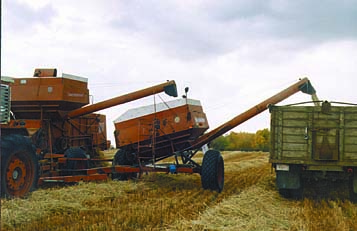
Over the years we've seen a lot of different ways to boost combine carrying capacity but we've never seen anyone take the approach of Edmond Riopel who patterned his unique add-on combine cart after old-style motorcycle side cars.
The Pickardville, Alta., farmer built his hopper "side car" out of a junked pull-type combine he originally bought for parts. He used the main frame, hitch and hopper to make the cart, which he pulls alongside his pull-type Coop 960 combine.
To pull the cart alongside his combine, he simply flipped the stripped-down frame of the combine over so it would run on the opposite side from his combine. He pulls both the combine and cart behind one tractor. He welded the hopper onto the frame at an angle.
The cart and combine are pinned together at three points -- at the hitch, at the pto, and at a "steady bar" which runs between the two units to hold them apart at the same distance. The wheels on the side car are parallel to the wheels on the combine so the cart doesn't hinder the operation of the combine whether turning in either direction or backing up. Because it follows the combine exactly, Riopel says it never gets in the way.
It took him only about 4 days to put the cart together and his only cost was for some pulleys and belts.
"The worst work was taking the old body off the combine," Riopel notes.
The unloading auger on the side car cart is powered by a pto shaft that runs across to the combine. Riopel rigged up a drive for the shaft by mounting a pair of drive pulleys on the main shaft coming out of the combine gear box. A telescoping pto shaft off an old swather runs between the two units.
Riopel mounted the hopper at an angle on the side car cart so it would fit under the combine auger and so that its auger would be high enough to unload into a truck. "I just guessed at what looked like the best angle," he says, adding that there was no modification to the combine unloading auger on combine so it can be used normally when the side car cart is not attached.
He can transfer grain from the combine to the cart and then to a truck on-the-go. Both unloading augers are controlled by electric clutches from the tractor cab. To transport the side car, Riopel simply unpins it from the combine and pulls it behind his grain truck. It takes only about 2 min. to hook it up to the combine. He mounted lights on the side car cart for night operation, and warning lights on the corners for safer transport.
The add-on hopper gives Riopel more time between unloading. He says it has another unexpected benefit: "On soft ground, you can divide your load between the two hoppers so all weight is not on the combine. This way you can get through a lot more mud. It also makes the combine pull straight on muddy ground. You don't get the side draft you normally get with a pull-type combine."
He also added plywood extensions to both hoppers. The side car holds about 225 bushels of wheat, for a total capacity of 400 bu.
